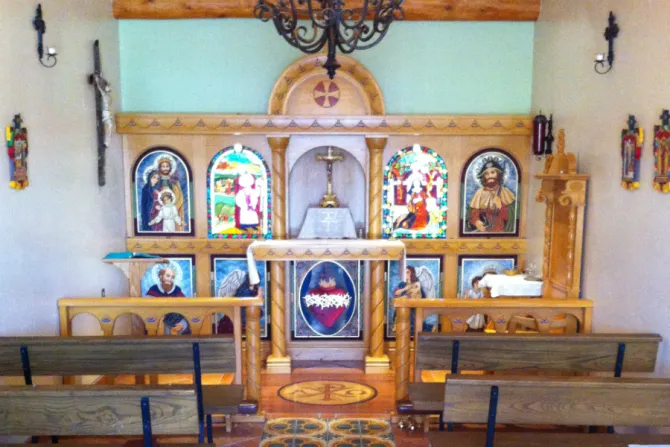Gallup, New Mexico, Apr 10, 2013 / 03:02 am
The newly-renovated chapel of Bishop James Wall of the Gallup diocese aims to be part of the spiritual formation of local seminarians as they prepare to pastor churches in the future.
"The idea was to make something peaceful and beautiful, and in God's honor...it's a house for discernment, and seminarians live there at time, so it's also intended to be part of their spiritual formation," Father Matthew Keller, the Gallup diocese's director of vocations and mission resources, told CNA April 8.
The chapel, attached to the bishop's residence, is located at a discernment house which is at times home to both priests and seminarians of the Gallup diocese. It has been renewed with sacred art from artisans who work in styles native to New Mexico.
"It's all along with the idea of demonstrating to seminarians how to go about seeking out the artists, encouraging, collaborating with the artists, thinking things through very carefully – what is the meaning of each aspect of the chapel, how to do things beautifully and according to the guidelines the Church gives us, following that as closely as we could, while keeping the local customs as well."
The process has been years in the making, and is nearly completed. The chapel has received a new altar and retablo, a celebrant's chair, sanctuary rail, stations of the cross, flooring, and an image of Our Lady of Guadalupe. A lectern and pews are still in the process of being prepared.
One of the priorities in commissioning the chapel, Fr. Keller said, was "to use the art that's unique and local," working with "New Mexico artists who are unique, and worthy as well."
The lengthy process has served to show the seminarians that the renewal and care of church buildings "doesn't happen overnight," and demonstrated "the patience involved, the fund raising, all the different things that go into it."
"But also it took a lot of work to do it locally," said Fr. Keller. "So many things it would be easier to just open up a catalogue...and you might find things that are beautiful that way, but it didn't really fit the model we were going for in this place, which was to serve 'artistic subsidiarity.'"
The style of art in the chapel, called "santero," is a folk art based on Spanish colonial art, explained Roberto Gonzales, who made the chapel's station's of the cross. Artists in the style make their own pigments, and it is "meant for prayer; it's meant for people to have these images in their house and use them more for prayer than as art."
Gonzales spoke to CNA/EWTN News April 9, noting that he and other artists in the style "reflect on the saints lives and what they went through, and what it means to have faith. And for the stations, when I was doing those, it was like re-living the Passion...it's a long process, and it's a prayerful process."
The process of making the stations took a year, as "you pray on each station, you reflect on what Christ was going through at that time, and what it meant, and what it means to humanity, and what it means to you as a person, and how it's affected the world, how it's affected all mankind, and it's just a beautiful thing."
The style allows for non-literal depictions of the scenes, as when Gonzales shows the Pieta as a large Mary holding a far-smaller Christ, to emphasize, that "he's her baby, a mother's child, and that's what she's mourning."
In the station in which Christ is nailed to the cross, the background is ethereal and disconnected from the earth, to emphasize the spiritual nature of what's happening, Gonzales said.
Gonzales emphasized that his work is prayerful and it's not so much for renumeration. Fr. Keller, on the other hand, said that for the Church it is important to give artisans due compensation for their work.
"The Church is supposed to be the patron of the arts, and not just a benefactor. Artists aren't expected to work for free, we want to support them and make that viable way of life."
He said that the chapel was provided through the donations of parishes and individuals who "believe in the project" and the importance of supporting priests, seminarians, and artisans.
(Story continues below)
Arlene Sena produced the paintings found in the sanctuary, and agreed that prayer is "the key to this tradition."
Sena produced images of the Holy Family, Saint James, Saint Francis de Sales, Our Lady of Mount Carmel, two angels, and the Sacred Heart. Each was chosen for a particular reason, out of importance to the Gallup diocese and to Bishop Wall.
The woodwork in the sanctuary is modeled on that found in the Gallup cathedral, and an image of Our Lady of Guadalupe was included because she is patroness of the diocese.
Sena told CNA/EWTN News that this chapel was "one of the best projects I've ever worked on," and said that "once you know who you're preparing these pieces for, it makes it so much easier to pray for those who will be serving in that chapel for years to come."
Gonzales emphasized again that prayer is central to his process of making art, and that it is for him an important way to promote the faith.
"I'm not a very good speaker, but I can pass the faith by doing art."
"And that's what it is for me, just spreading the faith.



